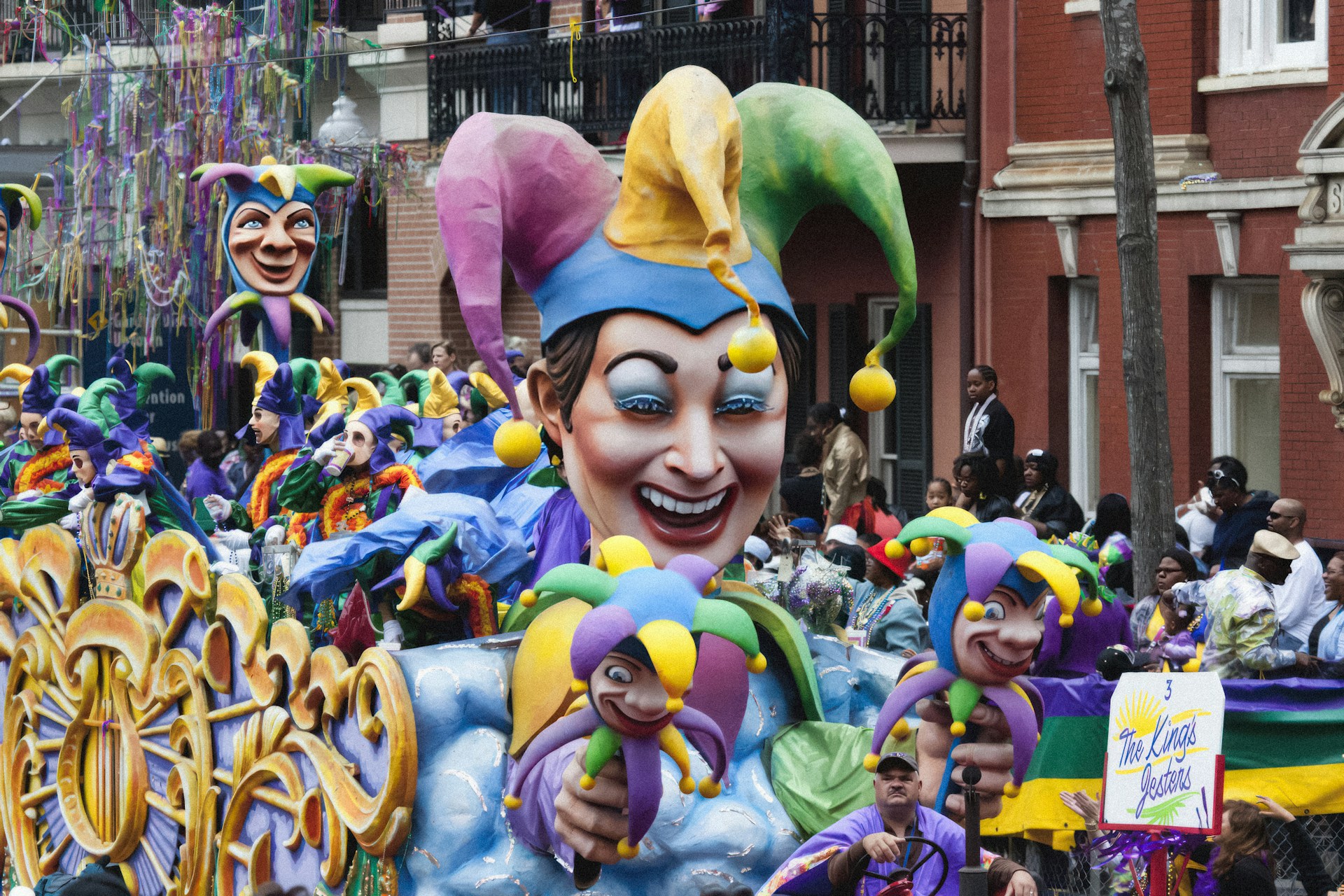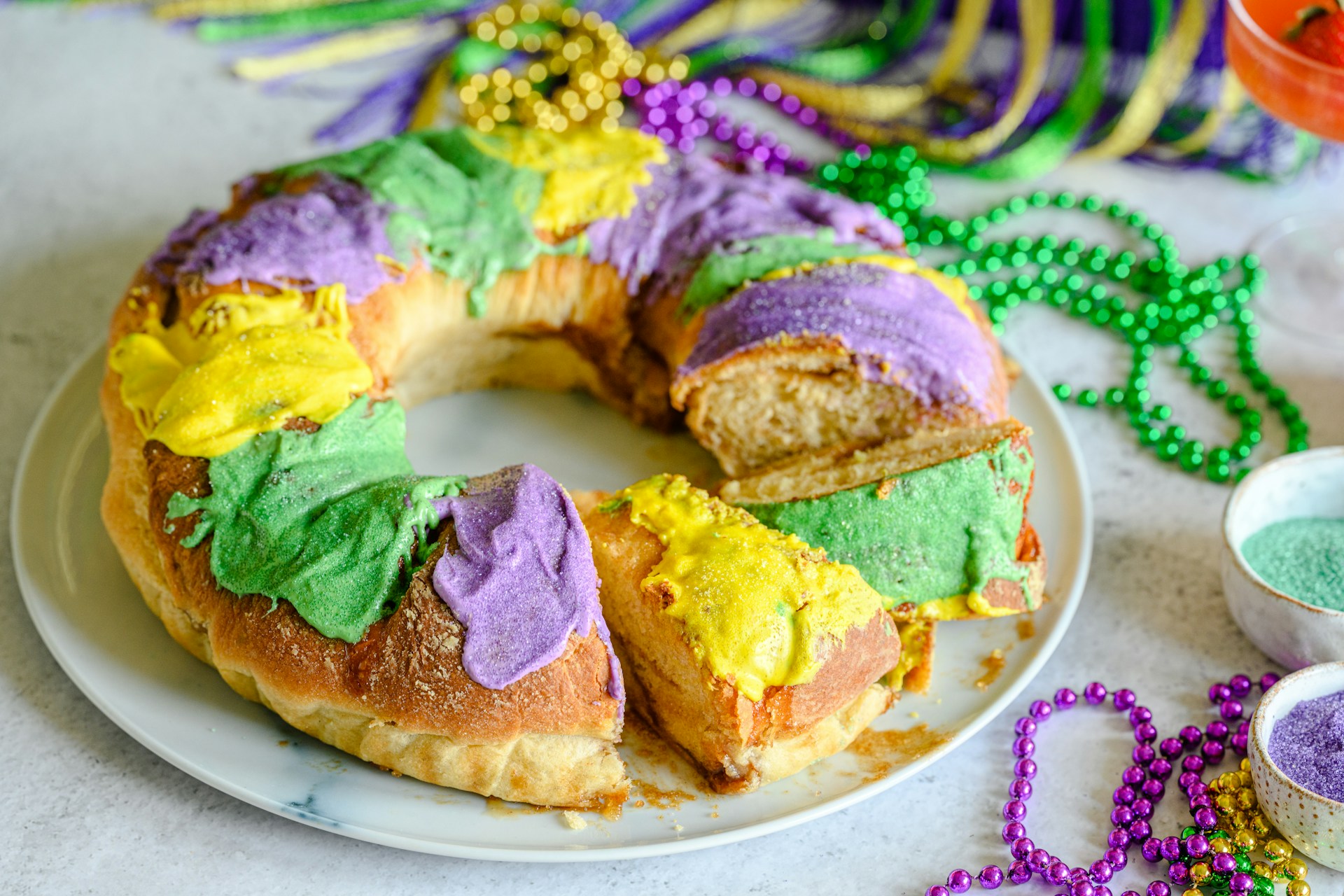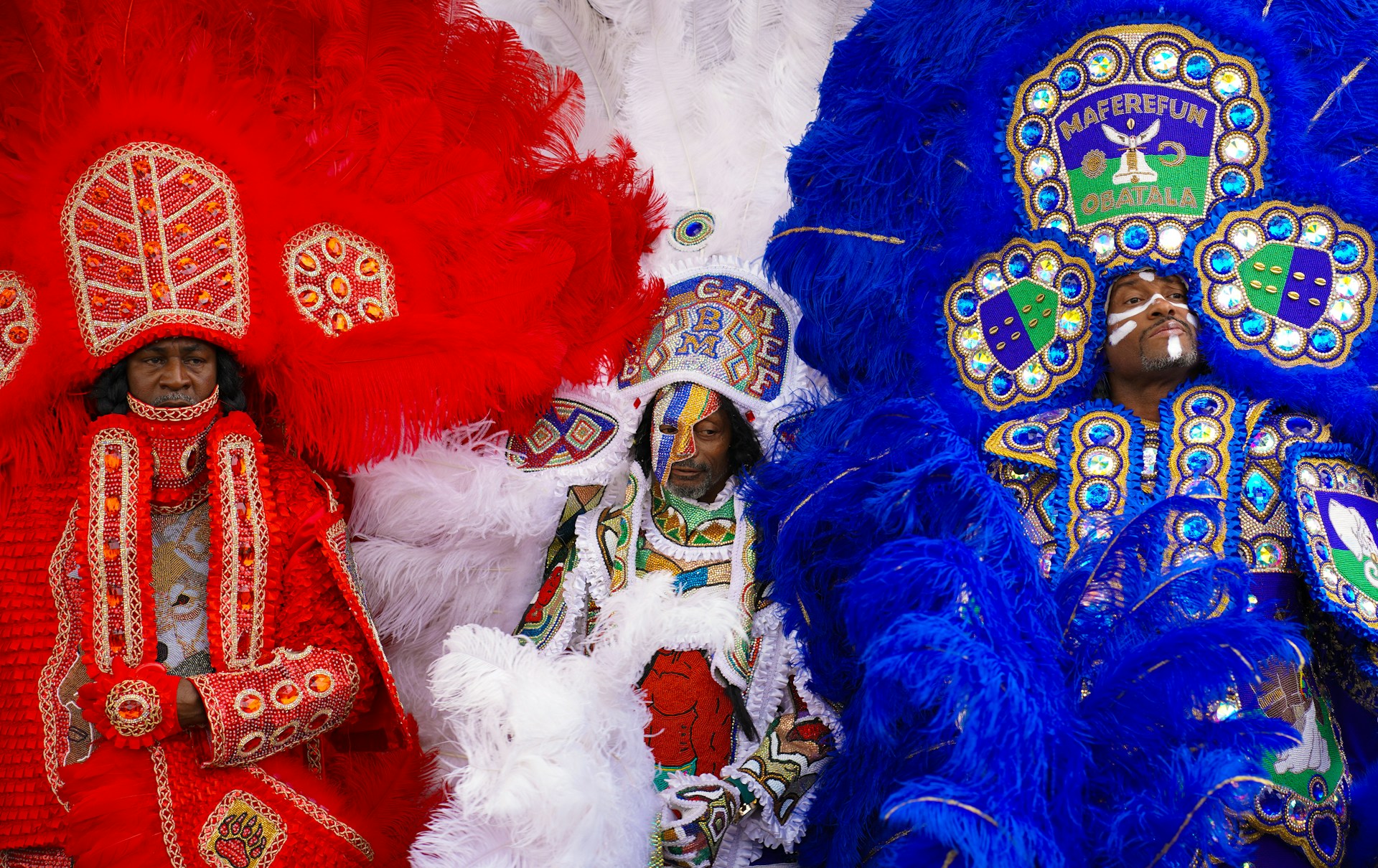17 Mardi Gras Facts You Need to Know About
Laissez les bon temps rouler (“let the good times roll”) during Mardi Gras this year. Carnival season is in full swing around the world from the beginning of January until the start of Lent and one of the most popular aspects of Carnival is Mardi Gras: the final Tuesday of the season. But did you know that there’s an official King Baby sports mascot or that there’s one place in New Orleans where you can see parade floats year-round? Whether you’re headed to New Orleans, the epicenter of Mardi Gras in the United States, or are celebrating Carnival’s conclusion in another city like Mobile, St. Louis, or Lake Charles, take a bit of trivia along with you – with these 17 insightful facts about Mardi Gras.
1. You’re not the first person to wear that string of beads
Millions upon millions of ‘favors’ are thrown from the floats during the festival, particularly beads. The beads have become one of the most iconic items associated with the celebration. The official colors of Mardi Gras are purple, green, and gold and they represent justice, faith, and power; and perhaps inadvertently symbolically, you won’t find virginal white anywhere on the string.
It’s impossible to say just how many beads are brand new, but one thing is for sure: Mardi Gras parades recycle beads from year to year. Many locals collect beads and drop them off at community offices that clean and prepare to reuse them the following year.
2. Mask wearing holds a special significance in the U.S.
Look at photographs from any Carnival celebrations around the world and you’ll see festival goers donning flamboyant masks. A parade in New Orleans is no different, though there’s a special significance to the mask wearing in the American South.
When racial inequality prevented African Americans from joining the Carnival celebrations, many used masks and costumes to attend the event. Interestingly enough, it’s against Louisiana law to wear masks, hoods, or any type of facial disguise in public, with one exception being Mardi Gras festivities. In fact, all float riders must wear a mask or paint their faces according to state law.
3. It’s just a day, not an entire season
Mardi Gras is such a popular event across the United States that many commercial festivities refer to the time as a “Mardi Gras season”. While the festivities may certainly be similar from day to day, there’s a big difference between Mardi Gras and Carnival.
Carnival refers to the entire period of time between January 6, which is the Feast of the Epiphany, and Ash Wednesday, which is the start of the Christian Lent. Mardi Gras is only the Tuesday before Ash Wednesday.

4. Mardi Gras is an official holiday
Making the distinction between Mardi Gras as a day and not a season is especially important in Louisiana. The Bayou State take it so seriously in its culture that Mardi Gras is an official state holiday. When you visit a city like New Orleans during Carnival, don’t be surprised if banks and government offices are closed on Mardi Gras.
5. The celebration has many names
Whereas Carnival and Mardi Gras are two separate names, the latter can correctly be referred to by many other names. The literal French translation for Mardi Gras is “Fat Tuesday”, which is one of its most common names. The day is also referred to as Shrove Tuesday. The week prior to the start of Lent is known as Shrovetide.
Similarly, since Mardi Gras marks the end of the Carnival season, it’s also called Carnival Tuesday. If you ever celebrate Shrove Tuesday in the UK, you’ll hear it referred to as Pancake Tuesday or Pancake Day. There’s not much mystery behind this title: English Christians would make pancakes to use up the last of their perishable goods in preparation for Lent.
6. The NBA celebrates Mardi Gras in a slightly terrifying way
If finding a small plastic baby in a king cake is good luck, then the New Orleans Pelicans must assume Carnival season will help them reach the NBA Finals. The official mascot for Louisiana’s basketball team is Pierre the Pelican, though during Carnival, he’s joined by a special guest: the King Cake Baby.
The King Cake Baby isn’t the most adorable mascot in the league; its strange appearance is unlike any other mascot in virtually every other American sports organization. It attends home games throughout Carnival season, including the annual Mardi Gras game that features the Krewe of Pelicans parade.
7. Mardi Gras is an evolution of a Roman celebration
One of our favorite facts about Mardi Gras has to do with its history. Shrove Tuesday we know it today is best known as a Christian holiday celebrated during the Middle Ages of Europe, but its true history dates all the way back to ancient Rome. Thousands of years ago, the Romans celebrated the coming of spring with their own festivals called Lupercalia and Saturnalia. Christianity evolved these celebrations into festivities of excess just prior to Lent.
Contemporary Mardi Gras still has ancient Roman elements in focus, like the king cake. Beans were originally baked into Roman cakes and whomever found the bean became the “king” for the day. The Christians kept the tradition and applied it to their Twelfth Night, or Three Kings’ Day, holiday which celebrates the three wise men visiting baby Jesus Christ. Today, they’ve swapped the bean for a plastic baby and some insist that whoever finds the baby is the “king” for the year — which bares the responsibility of buying the king cake for the next year’s festivities.
8. A Krewe is no ordinary club
Forming a Krewe for Mardi Gras — which is a group that organizes Mardi Gras parades each year — isn’t as simple as gathering your friends and dressing up on Mardi Gras. There are by-laws for forming Krewes and an expectation that the group can honor the tradition. Most Mardi Gras Krewes have a Board of Directors overseeing the Krewe Officers, Krewe Committees, and Krewe Members. Membership requires annual dues that fund the Krewe. All Krewes must also formally register with the Secretary of State of Louisiana. Some of the best known Krewes are Rex and the Mistick Krewe of Comus.
Save up to $3,000* per couple on your first Premium Tour
Plus receive latest offers, travel inspiration, and discover how your travels will make a positive impact. Together, WE MAKE TRAVEL MATTER®. Subscribe Now9. A Russian Grand Duke forever changed Louisiana Mardi Gras
In 1872, the Grand Duke Alexis Romanov Alexandrovich visited Louisiana to celebrate Mardi Gras. The Krewe of Rex was founded specifically to honor the visiting Russian royal, and ever since the Krewe has become known as the ‘King of Carnival’. Every year, the Krewe selects a new King of Rex each year, which is usually someone of importance, to receive a symbolic key to the city of New Orleans.
10. You need to be patient, not lucky, to get the best King Cake in NOLA
Dozens of bakeries in Louisiana cook up king cakes for Carnival season, but according to locals, there’s only one bakery that makes the best: Manny Randazzo’s King Cakes. Located in the Metairie neighborhood of New Orleans, the bakery opens annually in mid-December for Christmas cakes, followed by king cakes beginning on January 3rd. Hungry locals and tourists alike queue up in lines that stretch around the block — on busier days like weekends, the wait can be 2 to 4 hours long.
11. One of the most popular king cakes in the country is from a Vietnamese bakery
If you’re in the mood for king cakes but aren’t anywhere near The Creole State, many of the iconic bakeries will ship fresh king cakes across the country. One of the most popular is one of the most surprising. Dong Phuong Bakery & Restaurant is a James Beard Award winner that specializes in the sugary staple. It ships thousands of king cakes around the contiguous United States during Carnival season.

12. No Krewe parades in Orleans Parish can be commercialized
There’s a reason why you’ll never see a Krewe parade sponsored by any corporate sponsorship: it’s against the law in Orleans Parish. The city ordinance ensures that no corporate sponsors can get in on Mardi Gras, requiring that all expenses for the parades are paid by the individual Krewes.
13. Mardi Gras balls are invite only
Most people familiar with Mardi Gras are aware of the iconic parades, but Carnival season has more than one tradition. Mardi Gras balls are also held on Fat Tuesday, and if you’ve never heard of their existence, that’s the point. These elaborate events are almost always invitation-only. If the Krewe putting on the ball has a King and Queen that hid their identities throughout Carnival, the ball serves as the exciting unmasking.
14. The first Mardi Gras celebration wasn’t in Louisiana
Louisiana is synonymous with Mardi Gras, but the Big Easy can’t claim that it hosted the first Mardi Gras party in North America. That honor belongs across the border in Mobile, Alabama. Mobile is reportedly the oldest Mardi Gras celebration destination in the United States and it began in 1699 when a French-Canadian explorer arrived and threw a party.
15. There’s a micro parade making its way through New Orleans
Mardi Gras parade floats are extravagant and often larger than life in a literal sense, but there’s one Krewe that’s operating with smaller ambitions in mind. The MicroKrewe is the only one of its kind. Founded in 2009, ‘tit Rəx’ is the first Krewe that scrapped the giant parade floats and designs floats out of shoeboxes. Though small, these mini floats are just as elaborate and run a full route around Marigny in New Orleans.

16. You can see carnival floats year-round in New Orleans
Visiting New Orleans for Mardi Gras celebrations is an experience like no other, which is why hotel rooms fill up and travel prices skyrocket. But just because the king cake is gone doesn’t mean you can’t still learn about NOLA’s Carnival celebrations no matter the time of year.
Mardi Gras World is an attraction in New Orleans that offers a tour of the Blaine Kern Studio that builds Mardi Gras floats. Both self-guided and guided tours are available, and there are special packages that let you and a group make masks or miniature floats.
17. When is Mardi Gras?
Mardi Gras is always the final Tuesday of the Carnival season. Although Carnival season always begins on the same date, January 6, Fat Tuesday is always the Tuesday that falls 46 days before the Easter holiday. For example, Mardi Gras 2026 will take place on Tuesday, February 17th.
18. Where is Mardi Gras celebrated?
Mardi Gras is celebrated around the world. It’s also known as Fat Tuesday, Shrove Tuesday, and Pancake Tuesday. Louisiana cities like New Orleans are among the most popular Mardi Gras celebrations, but festivities take place across the United States, Brazil, and Italy, among other countries.
How old is Mardi Gras?
Mardi Gras has roots that date back thousands of years to ancient Roman festivals like Lupercalia and Saturnalia. The celebration as we know it today evolved in medieval Europe before being brought to North America by French explorers in the late 17th century. The first recorded Mardi Gras celebration in what is now the United States took place in 1699 near present-day New Orleans.
Why is it called Mardi Gras?
The name “Mardi Gras” comes from French and translates to “Fat Tuesday.” It refers to the tradition of indulging in rich foods and festivities before the fasting period of Lent begins on Ash Wednesday. The name originated from the practice of using up perishable ingredients like butter, eggs, and sugar before Lent’s fasting restrictions took effect.
What does Mardi Gras symbolize?
Mardi Gras symbolizes celebration, indulgence, and the transition into the solemn period of Lent. The holiday is known for its vibrant parades, music, and masked revelry, but it also carries deep historical and cultural significance. The official colors of Mardi Gras are purple (justice), green (faith), and gold (power)—were established by the Krewe of Rex in 1872 and continue to represent the spirit of the celebration today.

LIKED THIS POST? SHARE WITH YOUR COMMUNITY




